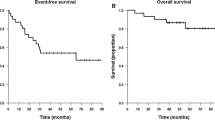Abstract
Diencephalic syndrome (DS) is a rare but rapidly fatal condition, usually occurring during the first year of life, as a result of a hypothalamic/chiasmatic tumor. The purpose of this study was to induce an objective tumor response and to achieve rapid weight recovery by using ten three-day courses of reduced-dose cisplatin–etoposide. Between 2004 and 2009, eight pediatric patients with DS as a result of an hypothalamic tumor and with a median age at diagnosis of 6.5 months (range 4–60 months) received 10 monthly courses of cisplatin (25 mg/m2/day on days 1–3) and etoposide (100 mg/m2/day on days 1–3). Under chemotherapy, rapid weight recovery was observed for all patients; tumor response was observed for six (75 %; partial response in four and minimum response in two). The other two had stable disease at completion of treatment. Mean time to weight recovery was 6 months (range 5–7 months) for pilomyxoid astrocytoma patients, and 3.3 months (range 3–4 months) for those with pilocytic astrocytoma. For DS patients who received nutritional support (enteral or parenteral nutrition) the mean time for weight recovery was 5 months (range 3–7 months) whereas children who were able to orally ingest a high-energy diet had a mean time for weight recovery of 8.66 months (range 3–19 months). After follow-up ranging from 22 to 89 months (median 38 months) all patients are alive. A low-dose cisplatin–etoposide regimen is highly effective regarding tumor response and treatment of DS symptoms/cachexia without causing significant side-effects.

Similar content being viewed by others
References
Russell A (1951) A diencephalic syndrome of emaciation in infancy and childhood. Arch Dis Child 26:274
Addy DP, Hudson FP (1972) Diencephalic Syndrome of infantile emaciation. Arch Dis Child 47:338–343
Burr IM, Slonim AE, Danish RK et al (1976) Diencephalic syndrome revisited. J Pediatr 88:439–444
Greenes D, Woods M (1996) Case report: a 4 month old boy with severe emaciation, normal linear growth and happy affect. Curr Opin Pediatr 8:50–57
Marec-Berard P, Szathmari A, Conter C et al (2009) Improvement of diencephalic syndrome after partial surgery of optic chiasm glioma. Pediatr Blood Cancer 53:502–504
Louis DN, Ohgaki H, Wiestler OD et al (eds) (2007) WHO classification of tumors of the central nervous system. IARC, Lyon
Massimino M, Spreafico F, Riva D et al (2010) A lower-dose, lower-toxicity cisplatin–etoposide regimen for childhood progressive low-grade glioma. J Neurooncol 100:65–71
Gnekow AC (1995) Recommendations of the brain tumor subcommittee for the reporting of trials: SIOP Brain Tumor Subcommittee-International Society of Pediatric Oncology. Med Pediatr Oncol 24:104–108
Gropman AL, Packer RJ, Nicholson HS et al (1998) Treatment of diencephalic syndrome with chemotherapy: growth, tumor response, and long term control. Cancer 83:166–172
Packer RJ, Lange B, Ater J et al (1993) Carboplatin and vincristine for recurrent and newly diagnosed low-grade gliomas of childhood. J Clin Oncol 11:850–856
Lafay-Cousin L, Holm S, Qaddoumi I et al (2005) Weekly vinblastine in pediatric low-grade glioma patients with carboplatin allergic reactions. Cancer 103:2636–2642
Gajjar A, Sanford RA, Heideman R et al (1997) Low-grade astrocytoma: a decade of experience at St Jude Children’s Research Hospital. J Clin Oncol 15:2792–2799
Laithier V, Grill J, Le Deley MC et al (2003) Progression free survival in children with optic pathway tumors: dependance on age and the quality of the response to chemotherapy—results of the first French prospective study of the French Society of Pediatric Oncology. J Clin Oncol 21:4572–4578 (French Society of Pediatrics Oncology)
Gururangan S, Fisher MJ, Allen JC et al (2007) Temozolomide in children with progressive low-grade glioma. Neuro Oncol 9:161–168
Schmandt SM, Packer RJ, Vezina LG et al (2000) Spontaneous regression of low-grade astrocytomas in childhood. Pediatr Neurosurg 32:132–136
Silva MM, Goldman S, Keating G et al (2000) Optic pathway hypothalamic gliomas in children under three years of age: the role of chemotherapy. Pediatric Neurosurg 33:151–158
Perilongo G, Carollo C, Salviati L et al (1997) Diencephalic syndrome and disseminated juvenile pilocytic astrocytomas of the hypothalamic-optic chiasm region. Cancer 80:142–146
Fleishman A, Brue C, Young Poussaint T et al (2005) Diencephalic syndrome: a cause of failure to thrive and a model of partial growth hormone resistance. Pediatrics 115:e742–e748
Massimino M, Spreafico F, Cefalo G et al (2002) High response rate to cisplatin/etoposide regimen in childhood low-grade glioma. J Clin Oncol 20:4209–4216
Murphy A, Drumm B, Brenner C et al (2006) Diencephalic cachexia of infancy: Russel’s syndrome. Clin Dismorphol 15:253–254
Distelmaier F, Janssen G, Mayatapek E et al (2006) Disseminated pilocytic astrocytoma involving brain stem and diencephalon: a history of atypical eating disorder and diagnostic delay. J Neurooncol 79:197–201
Chipkevicht E (1994) Brain tumors and anorexia nervosa syndrome. Brain Dev 16:175–179
Argilés JM, Busquets S, Lòpez-Soriano FJ et al (2006) Pathophysiology of neoplastic cachexia. Nutr Hosp 3:4–9
Bennati-Baiti N, Davis MP (2008) Cytokines and cancer anorexia cachexia syndrome. Am J Hosp Palliat Care 25:407–411
Plata-Salamàn CR (2000) Central nervous system contributing to the cachexia-anorexia syndrome. Nutrition 16:1009–1012
Skipwort RJE, Fearon KCH (2007) The scientific rationale for optimizing nutritional support in cancer. Eur J Gastroenterol Hepatol 19:371–377
Arends J, Bodoky G, Bozzetti F et al (2006) ESPEN guidelines on enteral nutrition: non—surgical oncology. Clin Nutr 25:245–259
Acknowledgments
Supported by: Associazione Italiana per la Ricerca sul Cancro (AIRC), grant RG-6232; “NOI PER VOI” Onlus; “Amicodivalerio” Onlus; Fondazione Tommasino Bacciotti; Fondazione Anna Meyer.
Author information
Authors and Affiliations
Corresponding author
Rights and permissions
About this article
Cite this article
Sardi, I., Bresci, C., Schiavello, E. et al. Successful treatment with a low-dose cisplatin–etoposide regimen for patients with diencephalic syndrome. J Neurooncol 109, 375–383 (2012). https://doi.org/10.1007/s11060-012-0903-7
Received:
Accepted:
Published:
Issue Date:
DOI: https://doi.org/10.1007/s11060-012-0903-7




